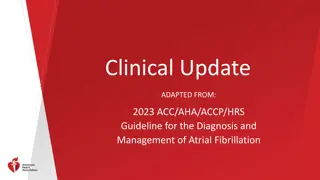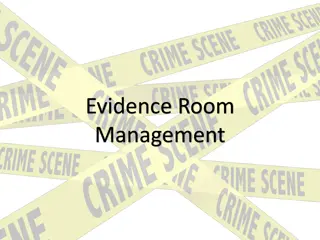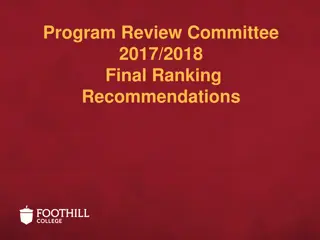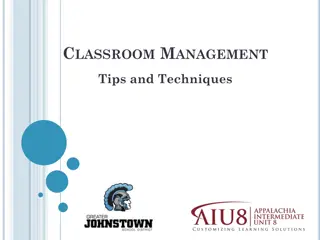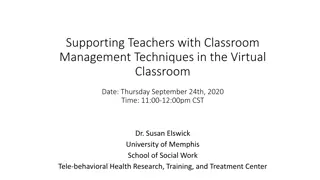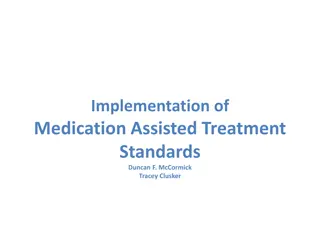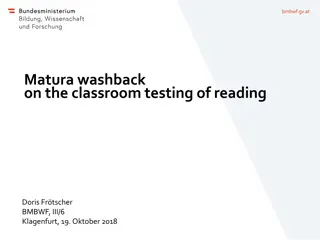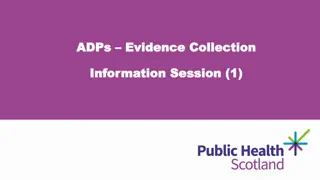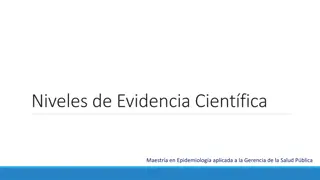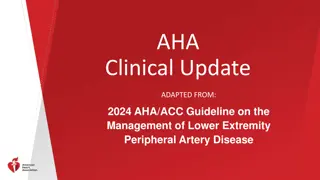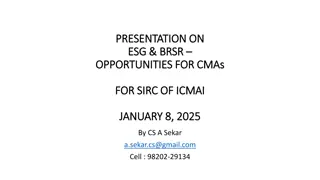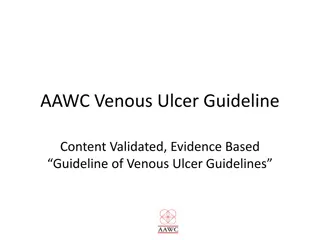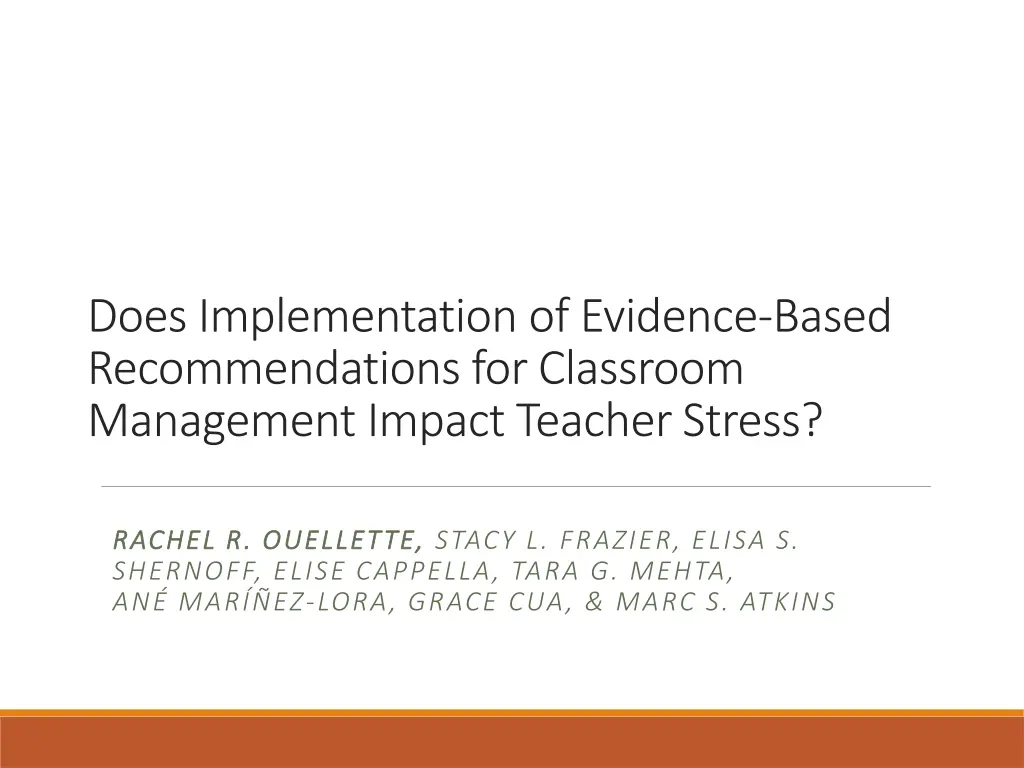
Impact of Evidence-Based Classroom Management on Teacher Stress
Explore the impact of implementing evidence-based recommendations for classroom management on teacher stress levels. The gap between service need and accessibility in urban communities and the call for increased evidence-based practice implementation in schools are discussed. While effective classroom management can enhance learning outcomes, the research highlights the lack of understanding regarding the effects on teachers' well-being, particularly work-related stress.
Download Presentation

Please find below an Image/Link to download the presentation.
The content on the website is provided AS IS for your information and personal use only. It may not be sold, licensed, or shared on other websites without obtaining consent from the author. If you encounter any issues during the download, it is possible that the publisher has removed the file from their server.
You are allowed to download the files provided on this website for personal or commercial use, subject to the condition that they are used lawfully. All files are the property of their respective owners.
The content on the website is provided AS IS for your information and personal use only. It may not be sold, licensed, or shared on other websites without obtaining consent from the author.
E N D
Presentation Transcript
Does Implementation of Evidence-Based Recommendations for Classroom Management Impact Teacher Stress? RACHEL R. OUELLETTE, RACHEL R. OUELLETTE, STACY L. FRAZIER, ELISA S. SHERNOFF, ELISE CAPPELLA, TARA G. MEHTA, AN MAR EZ-LORA, GRACE CUA, & MARC S. ATKINS
Thank you This research was conducted with support from National Institute of Mental Health Grants R21MH067361, R01MH073749, and P20MH078458 (Marc S. Atkins, PI) and National Institute on Drug Abuse Grant T32DA007293 (Robin Mermelstein, PI) There are no conflicts of interest Thank you to everyone from the larger L2L team, including: Elisa S. Shernoff, Elise Cappella, Tara G. Mehta, An Mar ez-Lora, Grace Cua, Sonja K. Schoenwald, and Marc S. Atkins
Bridging the Gap Well-identified gap between service need and corresponding access, including in large urban communities (Gonzalez, 2005) Identification Call by researchers, administrators and policy makers for increased implementation of evidence-based practice (EBP) for children and youth (Barlow, Levitt, & Bufka, 1999; Burns, 2003; Hoagwood, Burns, Kiser, Ringeisen, & Shoenwald, 2001) Call to Action Schools identified as one context for increased implementation due to accessibility to large number of children (Splett & Maras, 2011; Hoagwood & Johnson, 2003) Reaction
Implementation of EBIs in schools A rich literature highlights extensive effort to train teachers on evidence-based interventions (EBIs) to prevent and manage disruptive behaviors and engage learners (Bierman et al. 2013; Leadbeater, Gladstone, & Sukhawathanakul, 2015).
What we know We know that disruptive behavior interferes with overall classroom functioning and individual student academic achievement (Atkins, Hoagwood, Kutash, & Seidman, 2010) Effective classroom management can reduce disruptions and improve learning (Reid, Gonzalez, Nordness, Trout, & Epstein, 2004).
What we dont know Very little research has been done regarding the consequences of these implementation efforts for teachers personal well-being, including such outcomes as work- related stress (e.g., Shernoff et al, 2011; Ross, Romer, & Horner, 2012).
Work-related stress Stress is defined as an unpleasant emotional experience linked with specific environmental triggers and associated with feelings of anger, tension, frustration, and anxiety (Kyriacou, 2001)
Why is teacher stress important? Teachers have repeatedly reported higher levels of psychological distress and burnout when compared with other professions (Guglielmi & Tatrow, 1998 ; Kovess-Masf ty, Rios-Seidel & Sevilla-Dedieu, 2007)
Why is teacher stress important? Teacher stress has been associated with: Depression Burnout Physical illness Poor quality of life Increased staff turnover
Why is teacher stress important? Within the classroom, teacher stress has been associated with: Poor teacher-student rapport Decreased effectiveness in the classroom Decreased effective learning and implementation of EBIs
Teacher stress within urban schools A particularly high percentage of urban teachers have reported significant work-related stress (Shernoff, Mehta, Atkins, Torf, & Spencer, 2011) Reported contributors to stress amongst urban teachers include: Limited resources Overcrowding Chronic disruptive student behavior High-pressure accountability policies
EBI implementation and teacher stress Found that teachers in schools implementing Positive Behavioral Interventions and Supports with high fidelity reported significantly lower levels of burnout than teachers in low fidelity schools (Ross, Romer, and Horner, 2012) Little known about the mechanisms behind this association or potential moderators
Predictors of stress Most identified predictors of stress can be classified as either: individual-level (e.g. age, years of experience, perceived self- efficacy) or organizational-level predictors (e.g., school culture and climate, workload, principal leadership style, and role ambiguity)
Predictors of stress Most identified predictors of stress can be classified as either: individual-level (e.g. age, years of experience, perceived self- efficacy) or organizational-level predictors (e.g., school culture and climate, workload, principal leadership style, and role ambiguity)
Targeting student behaviors within the classroom Jennings and Greenberg (2009) burnout cascade model Work-related stress and burnout continue to build as teachers encounter increasingly difficult student behaviors they feel incapable of managing
Predictors of stress Organizational level predictors (e.g., school culture and climate) Classroom level predictors (e.g., student disruptive behaviors and academic achievement) Teacher stress Individual level predictors (e.g., self-efficacy, previous training)
Predictors of stress Organizational level predictors (e.g., school culture and climate) Classroom level predictors (e.g., student disruptive behaviors and academic achievement) Teacher stress Individual level predictors (e.g., self-efficacy, previous training)
Current Study The present study utilizes data from a large randomized controlled trial (Atkins et al., 2015), where six elementary schools in urban high poverty communities were randomly assigned to: a mental health service model for referred disruptive students (Links to Learning; L2L) or mental health services and professional development as usual (SAU)
EBI training and support within the L2L model L2L teachers (n = 71, K-4 general education teachers) received training and ongoing consultation to implement: two universal interventions (Good Behavior Game and Peer- Assisted Learning) and two targeted interventions (Daily Report Card and Good News Notes) Interventions included three behavioral interventions and one peer-assisted reading intervention
Study design Larger RCT utilized a 2 (L2L vs. SAU) by 6 (pre- and post-tests for 3 years) longitudinal design with random assignment of schools to conditions Data for current study focused on Year 2, due to available sample size
Study design Teachers in both conditions referred students with disruptive behavior problems to their school s partnering community mental health agency. L2L service model included: Team of teacher Key Opinion Leaders (KOLs), mental health providers (MHPs) and parent advocates. KOLs and MHPs facilitated professional development meetings for classroom teachers to disseminate interventions. Families received group-based and home-based family education and support provided by MHPs and parent advocates.
Study design SAU condition received: Routine assessment and intervention services from a mental health provider SAU teachers received professional development as usual, provided by the school district, with no additional trainings provided by the research team Note: Hypothesized effects of randomization to condition on predictors of stress examined in this presentation reflect the overall impact of the comprehensive mental health service model, as it is impossible to parse out the effects of any particular component, such as teacher training.
Included sample Of the 136 participating teachers, 54 teachers with complete data on the variables of interest in Year 2 (L2L; n = 32, SAU; n = 22) were included in the current sample. Mean SD Age 40.4 13.3 Total number of years teaching 12.5 10.8 Number of years at current school 7.1 8.4
Included sample % Gender Male 9.3 Female 83.3 Race/Ethnicity Black 55.6 White 27.8 Hispanic 3.7 Other 3.7 Not reported 9.3 Highest degree B.A./B.S. 38.9 M.A./M.S. 51.9 Ph.D/Ed.D 1.9
School characteristics Six schools randomly selected from among 325 schools in a large, Midwestern urban district based on under- performance of students on math and reading (as determined by school report cards) and proximity to participating community mental health agencies. Students within the 6 randomly selected schools: 98% low income 97% African American
Predictors of stress revisited Organizational level predictors (e.g., school culture and climate) Classroom level predictors (e.g., student disruptive behaviors and academic achievement) Teacher stress Individual level predictors (e.g., self-efficacy, previous training)
Current study Organizational level: teacher reported Organizational Health Classroom level: teacher reported student academic, social, and problem behaviors Teacher stress Individual level: teacher self-efficacy
Measures: Predictors Construct Rating scale Organizational Health Organization Health Inventory- Elementary (OHI-E; Hoy & Woolfolk, 1993) Student functioning Social Skills Rating System (SSRS) (Gresham & Elliott, 1990) Subscale for: social skills, problem behaviors, and academic competence Teacher self-efficacy Teacher Sense of Efficacy Scale (Tschannen-Moran & Hoy, 2001) Beginning of Year 2 scores used to predict end of year teacher stress
Measures: Teacher work-related stress Quality of Teacher Work Life (QTWL) survey (Pelsma et al., 1989) Teachers rated (1 = low to 5 = high) the extent to which each item (e.g., salaries, class sizes, competence of administration, student discipline, time required to adapt instruction) causes stress (i.e., How much stress? ) or satisfaction (i.e., How much satisfaction? ) Only stress subscale used for this analysis Intra-class correlations for stress by school were low at .062 No baseline differences between L2L and SAU teachers in mean stress, t (26) = .651, p > .05 Utilized scores from end of Year 2 (Stress: M = 2.90, SD = .813)
Measures: Covariates Potential covariates examined included: Teacher gender Race Ethnicity Age Years of teaching experience Years teaching at current school Highest level of education
Results Bivariate correlations revealed that teacher work-related stress was negatively correlated with organizational health total score (r = -.506, p < .01) Stress was not correlated with self-efficacy (r = .005, p > .05), or the average student score on the SSRS in social skills (r = .069, p > .05), problem behaviors (r = .105, p > .05), or academic competence (r = .100, p > .05). Stress was correlated with race (r = -.300, p < .05), and educational attainment (r = -.371, p < .01), such that teachers who identified as black, and teachers with masters or doctoral degrees, reported lower levels of work-related stress compared to their colleagues.
Results Multiple regression predicting stress then run based on significant bivariate correlations with predictors entered in three steps: Step one - race and highest degree Step two assignment to condition (dummy-coded; 1 = L2L, 0 = SAU) Step three organizational health
Results After controlling for demographic variables entered at step 1: L2L assignment was not significantly associated with teacher stress ( = -.024, p >.05). The addition of the condition variable did not account for a significant increase in variance, F (1, 44) = .030, p > .05, R2 = .001. Organizational health was strongly and negatively associated with teacher stress ( = -.525, p < .001) The model explained 21% of the variance in teacher stress, F (4, 43) = 7.973, p < .001, R2 = .426, above and beyond the teacher demographic characteristics and condition assignment included in steps 1 and 2
Results ANOVA revealed no differences between L2L and SAU teachers on beginning-of-year 2 total organizational health (F(1, 51) = .501, p > .05. ANOVA to test for possible differences in the five subscales of the organizational health inventory between the SAU and L2L groups. Only significant difference between groups on the academic emphasis subscale, F (1, 52) = 4.88, p <.05. Compared to SAU teachers, L2L teachers reported higher academic emphasis, including increases in students acting cooperatively, seeking extra work, and supporting peers who receive good grades. There were no other significant differences between conditions on institutional integrity, resource influence, or teacher affiliation.
What does this mean for teacher stress? The current findings lend support to efforts addressing organizational contributors to stress, such as: organizational interventions to improve an organization s culture organization-individual interface interventions focusing on building workplace relationships and support Results suggest that efforts focused on reducing student disruptions and improving engagement, while perhaps necessary to improve classroom functioning, may not be sufficient to improve school-wide social context factors, particularly in urban, low resource, high poverty schools.
Why other studies and not this one? Studies in other contexts (e.g., special education classrooms and community mental health agencies) implementing other interventions have found decreases in stress-related outcomes Urban schools serving high need, high poverty populations may present unique barriers which both impact teachers stress and impede our ability to improve these factors without addressing organizational barriers directly
Organizational Health revisited Our measure of organizational health included five subscales: institutional integrity (degree to which teachers perceive the school and its administration to properly educate students without undue influence from outside sources) collegial leadership (principal s high expectations and concern for the welfare of school staff) resource influence (principal s ability to obtain necessary material supplies) teacher affiliation (social satisfaction) academic emphasis (school s expectations for student achievement as well as students academic-focused behaviors and attitudes).
Organizational Health revisited Our measure of organizational health included five subscales: institutional integrity (degree to which teachers perceive the school and its administration to properly educate students without undue influence from outside sources) collegial leadership (principal s high expectations and concern for the welfare of school staff) resource influence (principal s ability to obtain necessary material supplies) teacher affiliation (social satisfaction) academic emphasis (school s expectations for student achievement as well as students academic-focused behaviors and attitudes).
Organizational Health revisited Our measure of organizational health included five subscales: institutional integrity (degree to which teachers perceive the school and its administration to properly educate students without undue influence from outside sources) collegial leadership (principal s high expectations and concern for the welfare of school staff) resource influence (principal s ability to obtain necessary material supplies) teacher affiliation (social satisfaction) academic emphasis (school s expectations for student achievement as well as students academic-focused behaviors and attitudes).
Organizational Health revisited Our measure of organizational health included five subscales: institutional integrity (degree to which teachers perceive the school and its administration to properly educate students without undue influence from outside sources) collegial leadership (principal s high expectations and concern for the welfare of school staff) resource influence (principal s ability to obtain necessary material supplies) teacher affiliation (social satisfaction) academic emphasis (school s expectations for student achievement as well as students academic-focused behaviors and attitudes).
Dual purposes Principal support has been found to be critical for successful implementation of EBIs as well as a predictor of teacher stress Teacher stress itself has also presented as a barrier for successful implementation Focusing on principal leadership and support may therefore serve a dual purpose in increasing successful implementation of EBIs with fidelity and decreasing teacher stress
Translating Research Into Practice Practice or policy implications for my stakeholders Generalizable practice or policy implications Increased training for principals and other school administrators around positive leadership skills (e.g., effective communication, setting and communicating appropriate expectations, expressing concern for staff) Increased opportunities for teachers to engage with and support each other, beyond support around EBI implementation Increased research is needed to fully evaluate the generalizability of these practice and policy implications Research teams should measure impacts of implementation efforts on provider health outcomes in order to better understand potential consequences or benefits for implementers, as well as how to maximize any identified benefits As available literature increases, larger reviews and meta-analyses should be conducted to examine for interactions between specific interventions or practices, training and support models, and contextual factors (e.g., organizational health)


